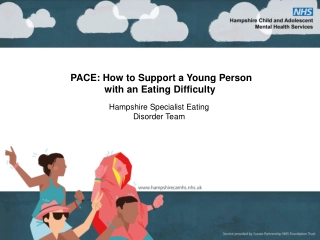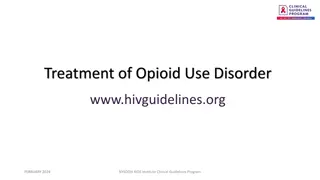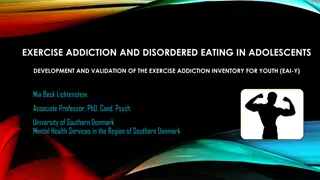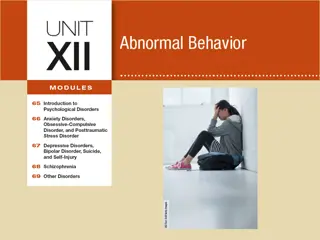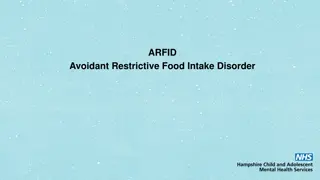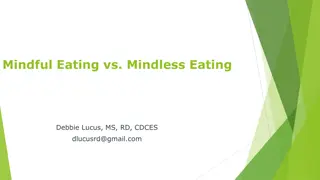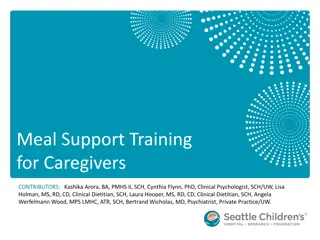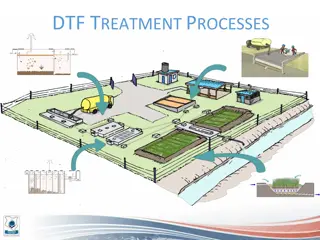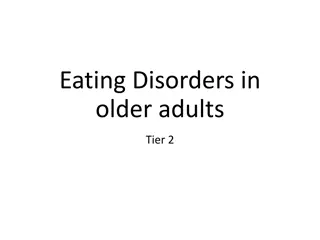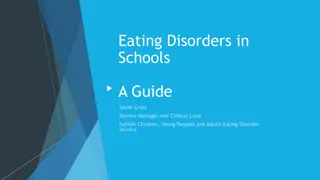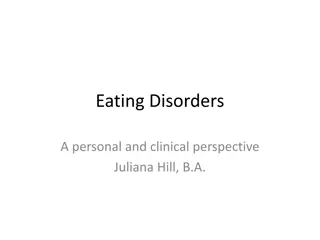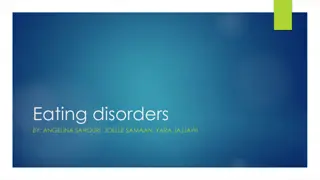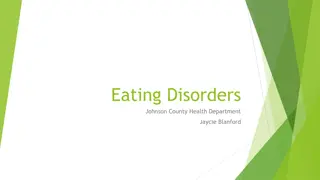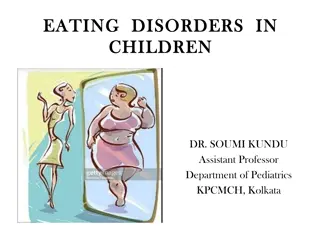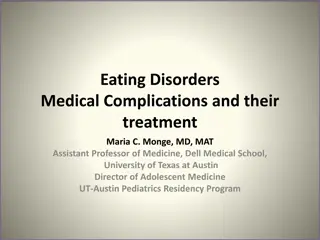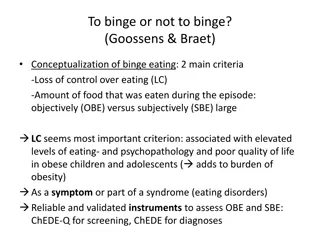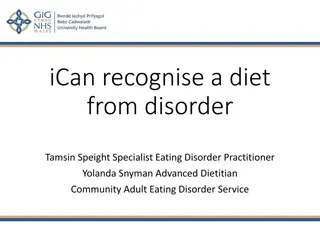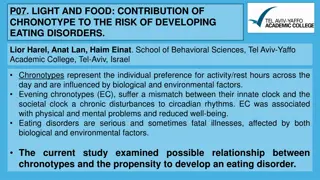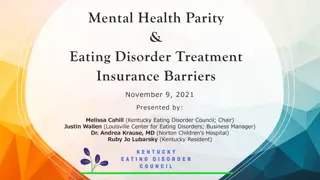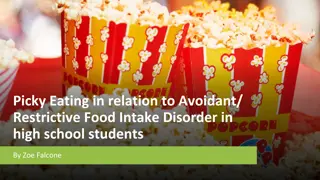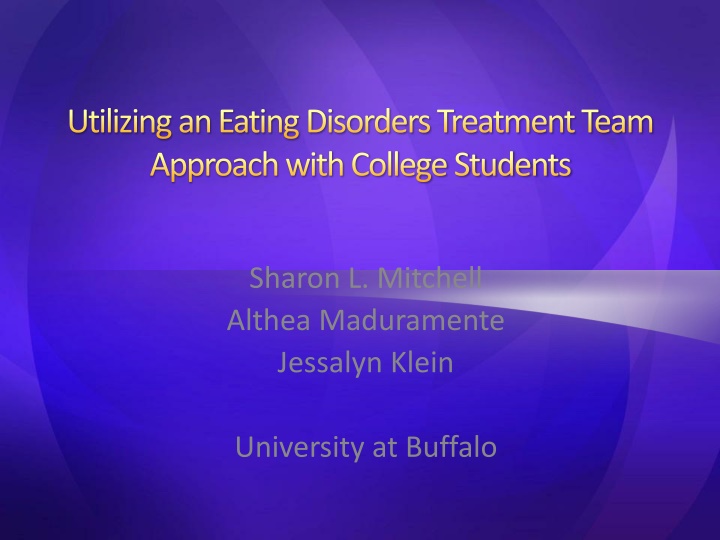
College Students and Eating Disorders: Treatment Team Approach
Discover the prevalence of eating disorders among college students, with insights into anorexia nervosa, bulimia nervosa, and binge eating disorder. Learn about the impact on college students' mental health and the goals and methods of eating disorders treatment, including individual, group, and family therapy. Explore the levels of care according to the American Psychiatric Association standards.
Download Presentation

Please find below an Image/Link to download the presentation.
The content on the website is provided AS IS for your information and personal use only. It may not be sold, licensed, or shared on other websites without obtaining consent from the author. If you encounter any issues during the download, it is possible that the publisher has removed the file from their server.
You are allowed to download the files provided on this website for personal or commercial use, subject to the condition that they are used lawfully. All files are the property of their respective owners.
The content on the website is provided AS IS for your information and personal use only. It may not be sold, licensed, or shared on other websites without obtaining consent from the author.
E N D
Presentation Transcript
Utilizing an Eating Disorders Treatment Team Approach with College Students Sharon L. Mitchell Althea Maduramente Jessalyn Klein University at Buffalo
Eating Disorders Types Anorexia Nervosa - self-starvation, excessive weight loss, and refusal to maintain a weight which is normal for one s height and age. These individuals often perceive themselves as being fat even though they are extremely thin. Bulimia Nervosa: a cycle of bingeing and compensatory behaviors such as vomiting, laxative and diuretic misuse, and excessive exercise. Eating Disorder Not Otherwise Specified: sporadic or chronic disordered eating patterns. However, these patterns do not meet the clinical criteria for AN or BN. Binge Eating Disorder, also known as compulsive eating
Eating Disorders & College Students 25% of college students attempt to control their weight using behaviors associated with Bulimia Nervosa (Renfrew Center Evaluation, 2003) Nearly 91% of female college students use dieting as a weight-control mechanism (Shisslak, et al., 1995). 5% to 20% of college females and 1% to 7% of college males have eating disorders (Johnson & Connors, 1987)
Eating Disorders and College Students In a national survey, 15% of college men and 27% of college women reported that it had been traumatic or difficult to handle their personal appearance in the past 12 months (ACHA, 2012) In a national survey of college counseling center clients, 27% of females and 13% of males reported a high level of distress related to Eating Concerns (CCMH, 2013)
Eating Disorders Treatment Goals Restore the person to a healthy weight Treat the psychological issues related to the eating disorder Reduce or eliminate behaviors or thoughts that lead to insufficient eating or overeating Prevent relapse
Eating Disorders Treatment Individualized but often include: Individual, group, and/or family psychotherapy Medical care and monitoring Nutritional counseling Medications
Levels of Care Based on the American Psychiatric Association Standards (2006) 1. Outpatient 2. Intensive outpatient 3. Partial hospitalization (full-day outpatient care) 4. Residential treatment center 5. Inpatient hospitalization
ED Treatment Team: Philosophy, Membership & Purpose Eating disorders are both psychological and medical conditions, thus care should address both. The EDT team consists of mental health professionals, physicians, and a dietitian who collaborate to provide appropriate assessment, intervention, and support to students with eating disorder concerns. The EDT team assists students in need of more intensive services in finding these services in the community. The EDT Team continues to assess a student's progress and make updated recommendations based on the student's progress and level of functioning.
Role of the physician To monitor physical health by checking vital signs. To draw blood or take urine samples, if necessary, to make sure the chemicals in the body are balanced. To order tests to monitor heart rhythm, bone density or if osteoporosis (thinning of the bones) is present or developing. To offer suggestions for achieving weight goals, calcium and vitamin supplements, exercise, hormone replacement, and possibly medication for anxiety or depression. To help determine the need for hospitalization & manage medical complications (e.g., arrhythmias, amenorrhea, osteoporosis, and electrolyte abnormalities). To refer to another specialist, if necessary
Role of the Dietician To help create a healthy eating plan To answer any questions about food. To discuss the harmful myths and confusing messages about food and diets. To provide nutrition counseling that includes teaching clients about what types of food their body needs, and how much food their body needs. To help their clients begin to incorporate challenging foods into their diets and learn to listen to physical signals of hunger and satiety.
Role of the counselor To improve self-esteem, body image, and confidence. To teach healthy ways to manage emotions and stressful situations. To address other emotional problems that may be related to the eating disorder, such as depression, anxiety, obsessive-compulsive disorder, or substance abuse. To provide a safe place to experience feelings of sadness, anxiety, anger, etc. To help clients learn how to challenge disordered eating thinking and behaviors, and teach strategies to become mentally healthy.
EDTT Process Points of entry: Health, Counseling & Wellness Consent form includes ability to consult with Health or Wellness Counselors explain the team concept Chair of ED team is informed of clients referred to the team Bi-weekly meetings ED consultation note is added to client file
Sample EDTT Consult: Routine Case Client feels that purging to avoid weight gain is not working for her and is motivated to make changes.
Sample EDTT Consult: Higher Level of Care Needed Client went to hospital emergency room for a GI bleed related to her purging. She has been bingeing and purging 1-4 times a day for the past 4 years and has struggled with her ED since age 12. She is also depressed and anxious. .Physician started her on Prozac and will see her weekly. Patient is medically stable to receive care at UB at this point.
EDTT: Demographics (n =150) Race/Ethnicity % Gender % Sexual Orientation % Male 12% Caucasian 77% Heterosexual 83% Female 88% Asian 9% LGBTQ 15% Unknown 2% Black 6% Academic Status % Hispanic 3% Age Undergraduate 63% Multiracial 3% Mean = 22.2 Graduate 37% Native American 2% Range = 17-46 Previous Counseling = 67%
EDTT clients vs. Other ED clients No specific criteria for referral to the team About 1/3 of ED clients were referred (n =66) 55 clients actually discussed at EDTT No significant demographic differences between those referred to the team vs. those who were not (e.g. race, age, gender, sexual orientation, academic status, diagnosis, initial GAF score)
Client Characteristics People who were referred to the team were much more likely to have been in counseling before. 77% of those referred had previous counseling as compared to 60% of those that were not referred. Graduate students with ED diagnosis were more likely to be discussed in EDTT than Undergraduate students 48% of graduate students were discussed compared to 30% of undergraduate students Type of Diagnosis 79% of those diagnosed with Bulimia Nervosa were referred to the EDTT 43% of those diagnosed with Anorexia Nervosa were referred to the EDTT 39% of those diagnosed with an Eating Disorder NOS were referred to the EDTT
Eating Disorders & Co-Morbidity Explored comorbid diagnoses including Adjustment, Anxiety, Mood, Psychosis, Substance, Sleep, Childhood, Medical, Impulse, Sex/Gender, Somatoform, and Personality Disorders. Only comorbid diagnosis significantly correlated with being referred to the EDTT was Personality Disorders (N=30). Of those diagnosed with a Personality Disorder, 73% were referred to the EDTT.
Counselor Characteristics In comparison to their female counterparts, male counselors were less likely to refer to the team. Male counselors referred only 6% of their clients compared to the 49% of clients referred by female counselors Of those 66 people referred to the EDTT, 62 were referred by their primary counselor Senior staff were most likely to refer to the team (62%). Doctoral level psychology interns referred 31% and part time trainees referred 8%.
Efficacy of the EDTT approach Those receiving the highest level of care tend to stay in therapy longer: Attended 14.6 more individual sessions, 4.6 more group sessions, and 19.2 more total sessions than the those clients receiving only group or individual counseling. Attended 10.7 more individual sessions and 14.6 more total sessions than just consulting and meeting with the physician. Attended 10.5 more individual sessions than those who were discussed in the EDTT but didn t meet with either the MD or nutritionist
Efficacy of the EDTT approach Those receiving just the EDTT consultation attended 4.3 more group sessions than the control group (not discussed at EDTT) 60% of people referred to the EDTT had planned terminations compared to only 30% of people who were not referred to EDTT People referred to EDTT were more likely to be referred to a group 73% of EDTT clients vs. only 28% for non-EDTT clients
Implications EDTT creates an environment that supports students staying treatment longer and ending in a planned fashion Staff, particularly, male staff may need more training regarding the benefits of the team approach May need to develop criteria for referral to the team to increase appropriate referral May need to require referral to the team given it s efficacy over psychotherapy alone
Next Steps Look more closely at treatment outcomes via symptom reduction on the CCAPS Depression, Generalized Anxiety, Social Anxiety, Academic Distress, Eating Concerns, Family Distress, Hostility, Substance Use, Distress Index Administered at intake, 4th, 8th, & 12thsessions Perhaps administer the EDI -2 with all ED clients

